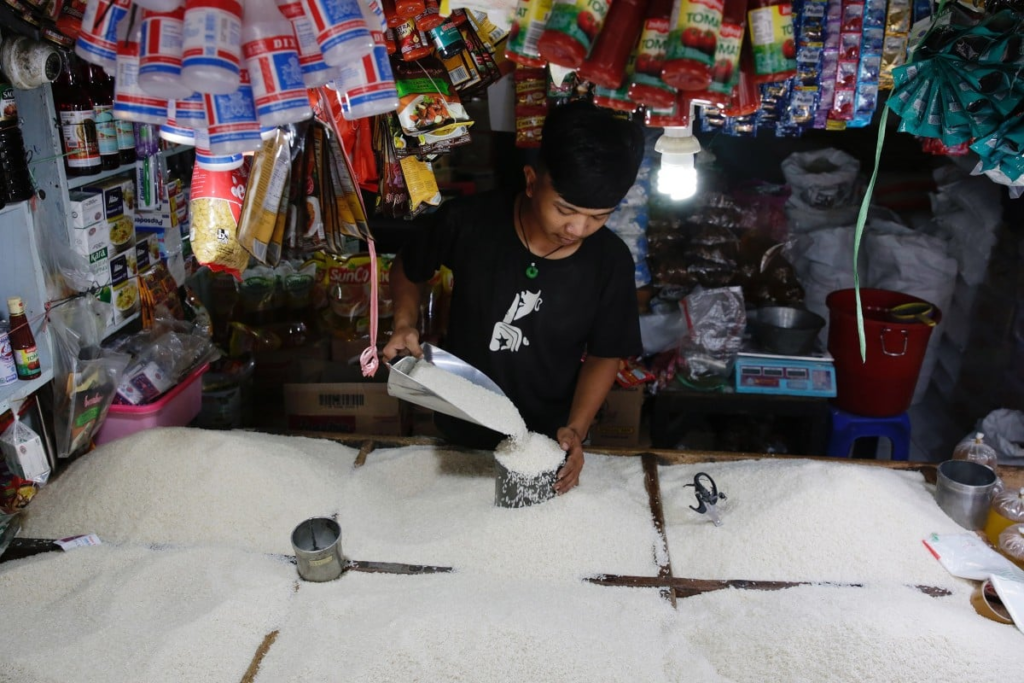Tags
Indonesia’s rice dilemma persists even with eased import curbs amid high prices
- Indonesia’s move to import more rice is facing opposition from local farmers who hope to get high prices for their crops
- The country also has other challenges ranging from stubbornly elevated rice prices to inefficient distribution

A rice vendor at a market in Depok, Indonesia. The Southeast Asian nation is the world’s third-largest rice consumer. Photo: EPA-EFE
Indonesia’s move to import rice from neighbours like China and Thailand to control a “serious” surge in prices is leading to backlash from domestic producers, highlighting Jakarta’s dilemma in balancing the interests of farmers against consumers, observers say.
State food procurement agency Bulog will import 2.3 million tonnes of rice this year to blunt the impact of the El Nino weather pattern, as hot weather in key growing regions across Asia threatens harvests. Indian export controls are also affecting rice prices.
The Southeast Asian country is the world’s third-largest rice consumer, with government data showing each of Indonesia’s 270 million people eats about 114.6 kilograms of rice per year.

Workers pack rice into sacks to be distributed to the poor families at a rice warehouse belonging to state food procurement agency Bulog in Banda Aceh. Photo: EPA-EFE
“Things are getting quite serious,” said Ronnie Natawidjaja, director of the Center for Sustainable Food Studies at Padjadjaran University. “The usual high-price time in Indonesia is December and March. Now it’s September and the prices are already high.”
At the end of August, the average price of medium-quality rice – the most commonly consumed type of rice – had risen by over a fifth year on year to 11,400 rupiah (73 US cents) per kilogram, according to data from Statistics Indonesia.
After decades of programmes to boost rice production, Indonesia achieved over 90 per cent self-sufficiency from 2019 to 2021, according to data from the United Nations Food and Agriculture Organization. However, this year the government imported 1.59 million tonnes of rice from January to August, with over half of the shipments originating from Thailand, government data showed. The figure is more than six times the 237,146 tonnes imported in the same period a year ago.
The National Food Agency (NFA) on September 26 said that Indonesia would also import 1 million metric tonnes of rice from China.
While Bayu Krisnamurthi, chair of Bulog’s supervisory board, said the situation was “encouraging for the few producers who still have a harvest”, the imports will affect farmers’ hopes for high prices for their crops.
The NFA had estimated the droughts in several parts of the country, worsened by El Nino, could shrink domestic rice output by 5-7 per cent this year from 31.54 million tonnes last year.
Around 21 million Indonesian families who qualify for food assistance will be able to claim from Bulog 10kg of the imported rice per month from September to November.
“Rice makes up about 40 per cent of calories consumed in Indonesia – it is easily the most common source of carbohydrate,” said Aditya Alta, head of research at CIPS. “Among the Indonesian poor, food contributes about 74 per cent of expenditure, with rice contributing 19-24 per cent.”
Experts say the government’s measures may not ease the pressure faced by the poor.
Natawidjaja said according to his research, only about 40 per cent of Indonesia’s food aid distributions reach the right people. “The other 60 per cent is usually going somewhere else,” he said.
Even if distribution were monitored more carefully, “there’s a limited extent that a government, or any large organisation, can influence trade prices”, said Charles Hart, a commodities analyst at BMI.

In Indonesia, rice prices are usually high by global standards even in years of strong harvests due to trade protectionism and import controls.
Last year, the wholesale price of rice in Indonesia was 70 per cent higher in domestic markets than international prices, according to research by the Center for Indonesian Policy Studies. Throughout the year, international prices for medium rice averaged US$0.42/kg, while Indonesia’s remained above the US$0.70/kg mark.
In August, global prices were 31.2 per cent higher than the year before, the most significant gain since the “rice crisis” of 2008, according to data from the United Nation’s Food and Agriculture Organization. That year, the price of rice increased by more than 300 per cent between January and May, due to poor harvests and exports controls, sparking food riots in some countries.
Import controls of low and high-grade rice have sometimes been relaxed. “However, when it comes to medium-quality rice, the policy has been largely unchanged, nor do we expect it to change in the near future,” Alta said.
Natawidjaja said reforms were needed to improve domestic farmers’ access to markets and increase farming of drier lands usually left fallow.
Indonesia also has to eventually diversify away from rice to less water-intensive crops – especially as global temperatures rise, he added.
Additional reporting by Reuters
https://www.scmp.com/week-asia/economics/article/3236509/indonesias-rice-dilemma-persists-even-eased-import-curbs-amid-high-prices?campaign=3236509&module=perpetual_scroll_0&pgtype=articlePublished Date: October 2, 2023







